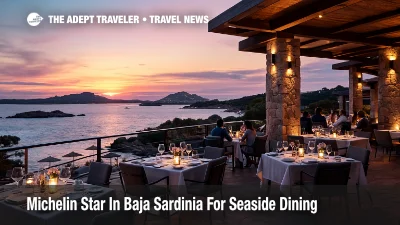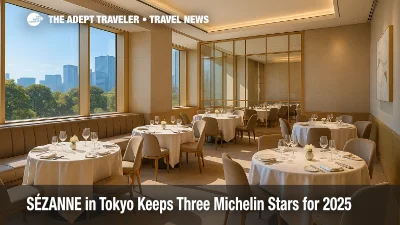MICHELIN Guide
Renowned for its iconic logo of a rotund, tire-like figure – the Michelin Man, the Michelin Company has evolved well beyond its automotive origins. One of its most ambitious endeavors has been in the realm of gastronomy – the prestigious and influential Michelin Guide. More than just a travel advice booklet, the Michelin Guide encompasses a full-scale culinary revolution, inspiring countless food-lovers to embark on unforgettable gastronomic adventures.
At its core, the Michelin Guide is a prestigious, annual ranking and review of the world's finest restaurants, hotels, and culinary experiences. Since its inception in 1900, the undertaking has evolved into a global brand that has managed to reinvent the relationship between cuisine and travel. The Guide serves as a reference for the world's most discerning travelers seeking to experience the best of what the culinary universe has to offer. Through a rigorous review process, the Michelin Guide continues to portray the art of fine dining in its truest sense. A symbol of exceptional quality, Michelin stars have come to represent the pinnacle of culinary achievement – sought after for their prestige as well as their potential to enhance a destination's appeal.
The Evolution of the Michelin Guide
The Michelin Guide is the brainchild of two French tire entrepreneurs – Andre and Edouard Michelin. The story began in 1900 with the very first edition of the Michelin Guide, aimed at assisting drivers by providing them with useful information such as various maps, petrol stations, and, importantly, good places to eat and drink. The Guide was initially intended for French motorists but gained rapid popularity, necessitating an expansion in 1904 to include neighboring countries like Belgium, Italy, Germany, and Switzerland. In 1920, the Michelin brothers redefined their Guide to include an anonymous review system to preserve the integrity of the ratings.
The birth of the modern Michelin star system can be traced back to 1926 when the Michelin Guide introduced a single-star rating, a symbol of excellence that was awarded to fine dining establishments. The three-star system that we recognize today was introduced in 1931, where one star represents "a very good restaurant", two stars signify "excellent cooking that is worth a detour," and the elusive three stars denote a dining experience so exceptional that it is "worth a special journey." In 1955, the Michelin Guide expanded globally, beginning with the Michelin Guide Italy. This marked a steady increase in the numbers of international locations receiving the coveted Michelin star ratings.
Today, the Michelin Guide continues to expand across the culinary landscape, providing restaurant classifications for more than 30 countries worldwide. The accreditation process remains as meticulous as ever, with Michelin inspectors visiting establishments anonymously to evaluate various aspects such as the quality of ingredients, skill level, consistency, and overall presentation. In recent years, the Michelin Guide has also broadened its influence in promoting sustainability and environmental responsibility within the culinary scene.
A New Era of Travel Experience: The Michelin Guide's Impact on Culinary Destinations
For many avid food-lovers and culinary enthusiasts, the journey to taste and savor exceptional cuisine transcends mere hobby and becomes a core element of their travel experiences. The Michelin Guide has played a significant role in shaping this trend, instilling the pursuit of gastronomic exploration as a cornerstone element of modern travel plans. In recent years, a renewed appreciation for world-renowned chefs, creative culinary styles, and innovative dining experiences has emerged, fueled by the growing influence of Michelin star-rated establishments.
Travelers now use the Michelin Guide as their primary source of inspiration when planning trips, often selecting destinations based on the restaurants and hotels that have earned Michelin stars. The Guide thus introduces a fresh perspective on defining one's travel priorities – where the promise of an outstanding culinary experience often outshines the allure of cultural attractions or scenic landscapes. This renewed focus on gastronomy offers travelers the opportunity to explore off-the-beaten-track destinations that may not have been on their radar and exposes them to new, eclectic flavors that can only be experienced on a culinary journey.
Destinations such as Tokyo, Paris, and New York City have experienced significant growth in culinary tourism, thanks to the Michelin Guide's rigorous evaluation process and reputation for quality. This trend has led to a burgeoning culinary ecosystem in these areas, characterized by highly-skilled chefs, exceptional culinary innovation, and evolving gastronomic experiences that captivate global attention. The rise of these culinary hotspots has further bolstered the status of the Michelin Guide, solidifying its reputation as a revered authority on international cuisine and travel.
Redefining the Future of Culinary Travel
As a world-class culinary institution, the Michelin Guide plays a pivotal role in shaping the future of gastronomy and travel. This influence is not static, but instead is continually evolving in response to shifting trends, preferences, and appetites. The Michelin Guide has recently demonstrated a commitment to spotlighting sustainability and environmentally-conscious practices in the culinary sector, through the introduction of the Michelin Green Star. This new accolade acknowledges establishments that have made significant strides in promoting a sustainable ethos and contributing to a greener future. This innovative undertaking attests to the Michelin Guide's ongoing dedication to adapting and evolving in the face of a dynamic international culinary landscape.
The Michelin Guide's impact on the world of travel extends far beyond a mere restaurant rating system. It has evolved into a global benchmark for excellence, an inspiring reference for travelers embarking on culinary tours, and a powerful influence shaping tourism and gastronomy trends. This distinguished institution has reimagined the essence of travel itself, transforming it into a vibrant culinary adventure that leaves an indelible imprint on the hearts and taste buds of those willing to indulge in the world's most exquisite cuisine.
Michelin Star In Baja Sardinia For Seaside Dining

Fairmont Amman earns one MICHELIN Key in global list

SÉZANNE in Tokyo keeps three Michelin stars for 2025

